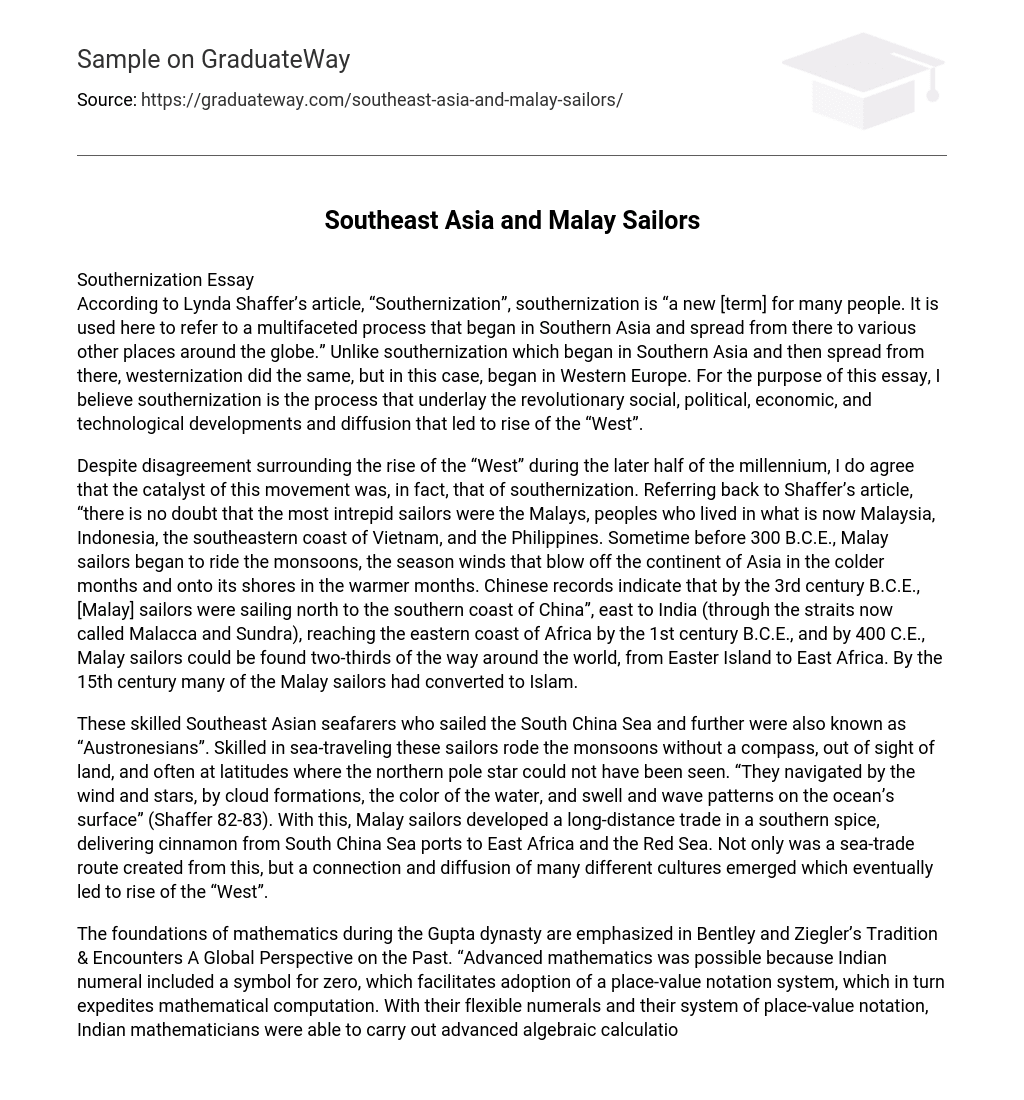Shaffer’s article, “Southernization”, southernization is “a new [term] for many people. It is used here to refer to a multifaceted process that began in Southern Asia and spread from there to various other places around the globe.” Unlike southernization which began in Southern Asia and then spread from there, westernization did the same, but in this case, began in Western Europe. For the purpose of this essay, I believe southernization is the process that underlay the revolutionary social, political, economic, and technological developments and diffusion that led to rise of the “West”.
Despite disagreement surrounding the rise of the “West” during the later half of the millennium, I do agree that the catalyst of this movement was, in fact, that of southernization. Referring back to Shaffer’s article, “there is no doubt that the most intrepid sailors were the Malays, peoples who lived in what is now Malaysia, Indonesia, the southeastern coast of Vietnam, and the Philippines. Sometime before 300 B.C.E., Malay sailors began to ride the monsoons, the season winds that blow off the continent of Asia in the colder months and onto its shores in the warmer months.
Chinese records indicate that by the 3rd century B.C.E., [Malay] sailors were sailing north to the southern coast of China”, east to India (through the straits now called Malacca and Sundra), reaching the eastern coast of Africa by the 1st century B.C.E., and by 400 C.E., Malay sailors could be found two-thirds of the way around the world, from Easter Island to East Africa. By the 15th century many of the Malay sailors had converted to Islam.
These skilled Southeast Asian seafarers who sailed the South China Sea and further were also known as “Austronesians”. Skilled in sea-traveling these sailors rode the monsoons without a compass, out of sight of land, and often at latitudes where the northern pole star could not have been seen. “They navigated by the wind and stars, by cloud formations, the color of the water, and swell and wave patterns on the ocean’s surface” (Shaffer 82-83).
With this, Malay sailors developed a long-distance trade in a southern spice, delivering cinnamon from South China Sea ports to East Africa and the Red Sea. Not only was a sea-trade route created from this, but a connection and diffusion of many different cultures emerged which eventually led to rise of the “West”.
The foundations of mathematics during the Gupta dynasty are emphasized in Bentley and Ziegler’s Tradition & Encounters A Global Perspective on the Past. “Advanced mathematics was possible because Indian numeral included a symbol for zero, which facilitates adoption of a place-value notation system, which in turn expedites mathematical computation. With their flexible numerals and their system of place-value notation, Indian mathematicians were able to carry out advanced algebraic calculations and anticipate the invention of calculus. Indian mathematicians calculated the value of pi to 3.1416 and the length of the solar year to 365.3586805 days.
In the eight century, Arab and Persian scholars encountered Indian mathematics and readily adopted what they called ‘Hindi numerals,’ which Europeans later termed ‘Arabic numerals,’ since they learned them through Arab Muslims” (213). Gupta prosperity sustained the work of scholars and enabled them to lay the foundations for sophisticated studies in mathematics.
As a result of these developments, India acquired a reputation as a place of marvels, a reputation that was maintained for many centuries after the fall of the Gupta Empire. These numerals, and the mathematics the Indians developed with them, are now universal — just one indication of the global significance of southernization which led to and helped achieve rise of the “West”.
In Shaffer’s “Southernization” article, it is said that “the influence of southernization continued during the Tang dynasty (618-906) and the Song dynasty (960-1279). The Chinese reformed their mathematics, incorporating the advantages of the Indian system, even though they did not adopt the Indian numerals at the time. They then went on to develop an advanced mathematics, which was flourished by the Song dynasty. Also in the Song period, the Chinese first developed cotton canvas, which they used to make a more efficient sail for ocean-going ships. (154-163).
Before the process of southernization, northern China was considerably more powerful and more wealthy than southern China. After southernization, southern China became the most prosperous and most commercial part of the empire. The Grand Canal was built in southern China to deliver crops to northern city. It was no coincidence that this dynasty felt the need to build a canal in southern China, which was also known as the “frontier area” in Shaffer’s article.
In conclusion, the “West” would not have risen as it did in the later half of the millennium if not for southernization. Without southernization, the “West” would have not risen as quickly or as efficiently as it had with it. The spread and diffusion of many different cultures, which were not confined by geography, allowed the “West” to have risen efficiently. Many cultures could not engage in all aspects of the process due to their distances. That so, very similar to times when a slave-encouraging America began to take shape.





